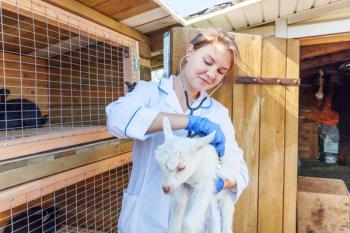
- dvm360 June 2022
- Volume 53
- Issue 6
- Pages: 28
An overview of critical care fluid therapy types

The different intravenous solutions administered by veterinary professionals were discussed at a recent Fetch dvm360® conference
When it comes to fluid therapy, veterinary technicians are typically the primary caregivers and are responsible for venous access and monitoring fluid therapy. Because fluid therapy treats critically ill and emergency patients, understanding types of fluid therapies can be a crucial part of a technician’s job.
At the recent Fetch dvm360® conference in Charlotte, North Carolina, Courtney Waxman, MS, CVT, RVT, VTS (ECC), veterinary nursing development manager at Veterinary Emergency Group in Fort Lauderdale, Florida, offered attendees a deeper dive into the different types of fluid therapy during her lecture.
Fluid Therapy 101
According to Waxman, in a physiological sense, the patient’s body is divided into 2 compartments: intracellular (ICF) and extracellular (ECF). These compartments comprise the body’s total water, with the ICF compartment using 66% of the water and the ECF using 33%.1
“When we think of normal total body water, most of the patient’s weight, just like most of us, is water,” Waxman said during her presentation.
“The intracellular is [approximately] two-thirds that’s taking up all the fluid in cells...we can’t control that too much. The fluid in a cell is pretty finite and predetermined. We [can] control its extracellular fluid space, which is the remaining third of total body water. This is further broken down into the interstitial space, so the fluid around tissue and organ groups is not in the intravascular,” Waxman continued.
The main type of fluid for treating critical patients is crystalloid fluids, which can be broken down into 3 categories: isotonic, hypertonic, and hypotonic solutions.
Isotonic crystalloids
Out of the 3 categories, the primary fluid type for treating critical patients is isotonic crystalloids, which are the most like a patient’s ECF. According to Waxman,1 75% of isotonic crystalloid solutions leave the intravascular space within 1 hour of administration. The maintenance rate of crystalloids in the small animal patient is 40 to 60 mL/kg/day.
The shock volume of isotonic crystalloids is 60 to 90 mL/kg in the canine patient and 45 to 60 mL/ kg in the feline patient. These doses should start
in aliquots, such as one-fourth or one-half of the shock dose.1
Hypertonic crystalloids
Hypertonic fluids have a higher osmolarity than your patient’s usual fluid composition. Even above the normal fluid composition, this solution can be lifesaving for emergency or critical patients because it offers a free water shift from the ICF to the ECF.
According to Waxman, the most common hypertonic solution is 7% to 7.5% sodium chloride (NaCl).1 Hyper-tonic crystalloids can also use a much smaller volume to obtain the restoration you want in your intravascular volume effect. Hypotonic crystalloids include 5% dextrose in water (D5W) and 0.45% NaCl.1
Conclusion
Although the responsibility of fluid therapy typically falls on the veterinary technician, this opens the door for technicians to be more involved in a patient’s fluid therapy plan. As veterinary technician roles continue to grow, the need for these professionals to understand all aspects of fluid therapy is crucial in continuing this growth.
Reference
Waxman C. Welcome to the IV league: fluid therapy in critical care. Presented at: Fetch dvm360® Conference; April 22-24, 2022; Charlotte, NC.
Articles in this issue
over 3 years ago
Taking Pride in Yourself and Othersover 3 years ago
Coenzyme Q10 use in petsover 3 years ago
Where’s the money?over 3 years ago
“Hello, I Must Be Going”: Groucho joins the familyover 3 years ago
Advanced laser surgery, and digital cytology elevate pet careover 3 years ago
Iatrogenic hypothyroidism in catsover 3 years ago
Cultivating the colon: Probiotics and prebioticsover 3 years ago
Talking pride in the veterinary professionNewsletter
From exam room tips to practice management insights, get trusted veterinary news delivered straight to your inbox—subscribe to dvm360.




